Monday was a banner day – several needlework books I’ve been itching to own were delivered to my front door, and though I couldn’t spend all afternoon with any of them, I did get to linger over one with my lunch and a cup of tea, followed by another cup of tea, followed by…. you get the point!
I’ve been dying to own Jane Nicholas’s beautiful book, Stumpwork Embroidery: A Collection of Fruits, Flowers & Insects for Contemporary Raised Embroidery, for a long time. It was worth the wait…
For beginner embroiderers, you might think I’m nuts if I told you that you CAN do this stumpwork stuff. Yes, it generally falls under “intermediate” or “advanced” techniques, but if you find you are getting the hang of beginning stitches and you’re liking your new-found embroidery hobby, don’t think you have to wait years, practice your fingers off, and relegate yourself to backstitch for the rest of your life because you consider yourself a “beginner.” Not so, not so!
If you understand how a needle works (you stick thread in it and use it to manipulate the thread in and out of fabric), then you really can enjoy this type of embroidery. All it takes is a little gumption and some commitment to trying it!
I only bring this up because this is often the reaction of relative newbies to types of embroidery like stumpwork or goldwork.
In fact, the first remark a friend – who is just getting into surface embroidery – made upon seeing the book was, “I could never do that.”
When I protested, she insisted it would take “years” before she was good enough to do stumpwork! So we talked over the book, read some of the instructions, looked at the diagrams, and eventually she said, “I could probably make that bee…” followed by, “I think I’ll try that bee, and the hive, too…” And now, she’s sold, and determined to do it! (I told her to buy her own book!)
As we were growing up, my Mom always said, “I Can’t is a sluggard too lazy to work.” I don’t know if that’s always true. There are some things I know I can’t do – I can’t ski, I can’t run a 25K marathon (not even a 10!), and I can’t eat bananas raw without gagging. True, I haven’t tried the first two, but I’m pretty sure I’d be putting my life seriously on the line! Lazy? Perhaps!
The fact is, I’m not really interested in taking up skiing or running a 25K marathon. Niether is something that I’d put my mind to or energy into.
But if you have a genuine interest in something, especially something like needlework of this kind, if you put your mind to it, despite your current skill level, I think it’s something you can do! Yes, it may take a little practice – like skiing or long-distance running – but you can do it!
So if this grabs your attention – if it makes you say to yourself, “Wow – I’d love to do something like that!” don’t be inhibited by thinking you’re “not good enough yet.”
That’s my pep talk.
Here’s the book.
I’ll show it to you and then discuss my personal pros and cons.

The cover is beautiful. It’s a hard-bound book and looks well made. It’s one of the Milner Craft Series books, and they generally do a very nice job on their books, I think. The cover reminds me a lot of Celia Fisher’s books on illumination, if you’ve ever seen those…
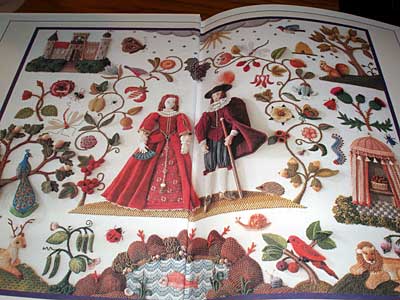
When you open the book, you’re met with this Jane Nicholas masterpiece on the endpapers of the book. I’ve seen this piece on the Jane Nicholas Stumpwork Embroidery website – in her gallery – but on there, you can’t really get upclose to the piece.
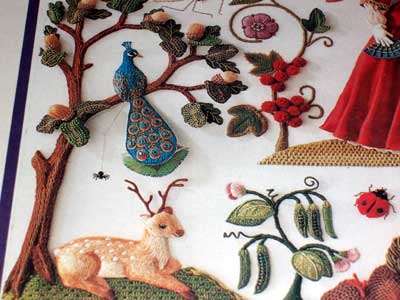
But in the book, you can see such beautiful detail. You can linger over each little motif in the picture. I almost think the endpapers are worth the cost of the book, I got so much pleasure from looking at them!
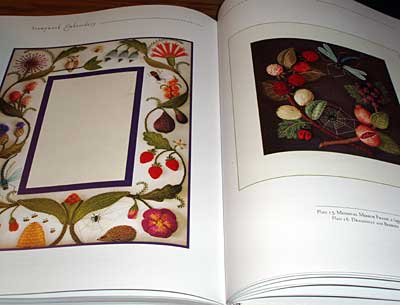
About half-way through the book, you start to run into color plates. The first half of the book is black and white instruction, with line drawings and so forth – but the last half of the book is definitely the icing! Colored projects are depicted in their glory – simply, on white pages, some of which just have a little 4″ x 4″ colored photo smack in the middle. But what a photo!
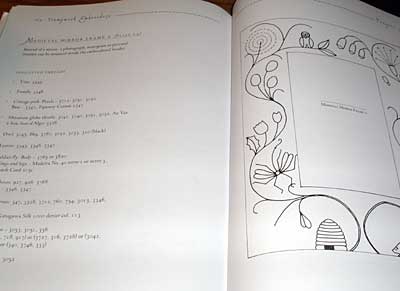
The projects featured in the book include a supply list, instructions on working the project, a color plate of the finished project, and a line drawing of the pattern. The instructions are titled “Order of Work,” which is nice. They take you step-by-step through completing the project, cross referencing Chapter 3, “Individual Elements.”
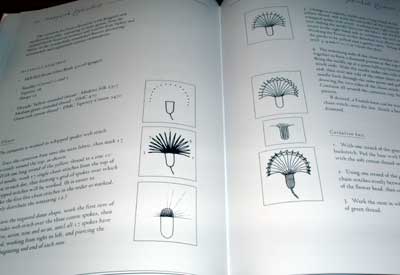
In Chapter 3, “Individual Elements,” the author instructs on creating each type of technique. This is where you learn to work each element featured in the projects – from grasshoppers to flower petals to leaves to bees to hives to caterpillars, and so on.
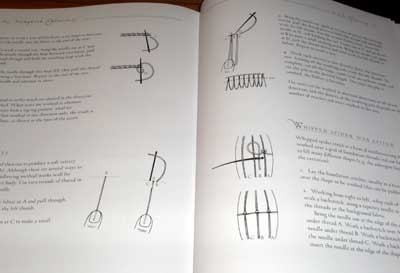
The last chapter of the book is a stitch glossary. From the simple backstitch to turkey work to needleweaving to trellis stitch, every type of stitch you need for the projects in the book is explained. The stitches are illustrated with line drawings, usually several per stitch.
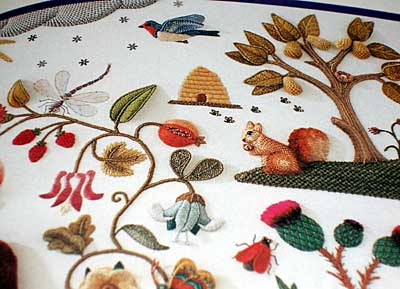
And the book ends with the same picture with which it begins.
All in all, it is a beautiful and useful book for the embroiderer interested in stumpwork and raised embroidery techniques.
Like most good embroidery books, the first chapter is dedicated to materials and equipment. Here, you’ll find information on the threads, wires, hoops and frames, needles, etc. needed for stumpwork. The majority of threads used throughout the book are DMC, though the author does list several other useful types of threads, which you will also find required in some of the projects.
The second chapter is devoted to general instructions about stumpwork – methods for stitching over wire and attaching separate elements to a motif, how to stitch a leaf without a central vein, how to use felt with small pieces of different elements (using fusible interfacing), using organza, and so forth. You’ll also find a nice section in this chapter on finishing techniques, from mounting work on a box lid to making a paperweight & brooch, to lacing embroidery to a board before framing. All in all, a nice, thorough chapter of general, useful information.
Chapter 3 is discussed above. Chapter 4 contains all the projects in the book: four types of brooches; a rose, pomegranate and strawberry piece; a rose and bee; acorn thistle and bee; acorn, thistle, and butterfly; butterfly and berries; Christmas rose and dragonfly; pomegranate and go
oseberries; Christmas acorn and berries and Christmas acorn and pomegranate; dragonfly and berries; hellebore, berries, and dragronfly; Christmas rose, berries, and dragonfly in white; and two Medieval mirror frame patterns.
Chapter 5 – the stitch glossary – is mentioned above. The book closes with a bibliography and suggested further reading, a thorough index of the book, and, finally, information on ordering stumpwork supplies, kits, etc., from Jane Nicholas.
Pros & Cons
Pros: Wow, the pros are almost too many to mention:
The book is clear, clean, bright, and crisp – a nice, quality book with excellent content. The pictures are gorgeous, though there aren’t a lot of them. The layout of the book is functional and pleasing: the cross-referencing in the projects page to the individual elements and stitch glossary is effective. The fact that the reader is instructed on many different individual elements is conducive to further creative endeavors with stumpwork – you certainly aren’t limited to just the patterns in the book.
Cons:
I would like to have seen more elaborate stitch instructions. Two or three diagrams don’t always do it. Still, by reading and referencing the diagram, anyone should be able to accomplish the stitches explained in the glossary.
I was also initially surprised by the lack of color throughout the book. Don’t get me wrong – there are many beautiful color plates of the projects in the last half of the book. As previously mentioned, each project has a color plate that corresponds with it. My initial surprise gave way to admiration, though, for a nice, clean, clear book. There’s nothing “cluttered” here – the book seems enticingly simple in all regards, though dealing with a much more complex form of embroidery.
This is one of those books that I’d put on the “highly recommended” list. It is fascinating to read, a pleasure to browse through. I like it a lot!
If you have the book, what are your thoughts on it? Do you like it? Have you found it a helpful and instructive reference?
Where to Find It
You can find Stumpwork Embroidery: A Collection of Fruits, Flowers & Insects for Contemporary Raised Embroidery available through the following book affiliates:
Used, Stumpwork Embroidery, etc. is available here through Amazon at very good prices right now (updated Oct, 2016)







I’m ashamed to say that I’ve had this book for a long time. But I’ve been afraid to try the technique, even though I think it is stunning. However, just so I won’t be accused by your mother of being lazy, I am now inspired to give it a try. Thanks for you great review!
Cissie
This is one of my most treasured books. I’m a stumpwork fanatic and I use Jane’s books all the time. I think it takes a while to get used to how it’s organized (with the individual motif instructions in the front) but it’s quite useful especially when you’re putting together your own design. I think the lack of color forces you to use your own imagination – for instance, for a specific project she’ll give color suggestions but with the way the individual instructions are laid out, you can just as easily use the instructions with your own color choices.
celeste
Thanks for one more excellent review, Mary!
And you are so optimist and supportive to the begginners like me – you make me dreaming i can do such a work!
In fact since I read you I’ve tried so many new stitches and made things I’ve never thought to make, so … who knows? 🙂
I just wish it had an index at the back …for the various motifs and techniques.
As it is, you have to flip through looking for the project a specific motif is in and get the reference from there, or hope to happen upon the pages explaining the motif itself.
Long time rss follower, it’s taken stumpwork to pull me out of hiding 😉
This was the first stumpwork book I bought all those many moons ago and I must admit I found it confusing. The instructions weren’t as detailed as I needed at that point and I spent longer battling with comprehension than I did with the needle. I would recommend total beginners to start with kits, or patterns from Inspirations etc first.
That said it is a beautiful book and I often pull it out just to peruse again. I also have the follow-ups: Stumpwork Designs and Projects; the beetle collection; and the dragonfly collection. Even if you never do a project from them, they’re worth their weight in drool value.
🙂 I have this plus the Designs & Projects one (came next?). Also a Beginners Guide to Stumpwork.
Like Cissie I've only admired mine (a very long time as well) while I work up the courage. Almost ready?
Maybe we need a Stump-A-long Challenge 🙂
Right now I'm on the hunt for Hardanger Picot tutorial…they'll be my first ones I think.
Like several others, I’ve had this book for several years and have yet to muster the courage to actually try anything from it. It’s a beautiful book though and I love looking at it.
I bought this book many years ago and absolutely adore it. It was my first exposure to stumpwork. Jane Nicholas is still my favourite stumpwork designer. Like other commenters I have also bought all of her other books. She is one of a small number of needlework authors whose books I will buy sight unseen.
I use her books for inspiration and ideas as her design sense really appeals to me. These books also caused me to fly across the country to take a class with Jane which was a terrific experience.
I highly recommend Jane Nicholas’s books and her classes. If you ever get the chance to take a class with her do it! Also, don’t worry if you don’t think you’re ready. The experience is definitely worth it and you’ll learn a lot.
Will you be showing us some steps regarding stumpwork. I have always looked at stumpwork and don’t know how to start it.
Donna
Hi, all!
Thanks for your comments! I really find I like this book a lot and am itching to work one of her projects. I have another little stumpwork project, though, that I’ll probably work first.
Donna, yes, eventually, I’d like to show some stumpwork techniques. The next video I have coming up features a stumpwork technique, if I could only get the video together!
Thanks again for the comments!
MC
I bought this book in a different title, "The complete book of Stumpwork Embroidery." basing on the photos of the projects you posted, I think it is the same, just a different name. mine is a reprint 2005.
I also have The Complete Book of Stumpwork Embroidery. It is not quite the same book, though many of the projects look similar. The difference in this book is the detail of specifically medieval flora found in illuminated manuscripts. I really love her books. I can't stop looking through this one!
donde puedo conseguir el libro estumpwork embroidery aqui en colombia. por favor que alguien me responda y si se conoce con otro nombre esta tecnica. mil gracias
Dear Mary,
I like very much stumpwork but found until now the models quite “kitch”. I wanted something else so – of course – I went to you site book review and found this book. I went to the author’s site and there I discovered a book called ” the complete book of stumpwork embroidery” bringing together in one volume the first 2 titles from Jane.
I ordered it Friday, received it yesterday (Amazon apologizing for not sending in the week-end !) and all I can tell is that it is gorgeous ! 400 pages instead of 200, the content of 2 books and the pleasure of a luxury edition (Milner craft series) … I start my first project today !
Thank you so much for your help and please keep going : I look at your site every day and cannot miss it !
I just got the complete book of Stumpwork after a long search and I am delighted, ecstatic and cant believe my luck to have found it at a local book store…..
I bought this book together with the A-Z of Stumpwork from Country Bumpkin. Two very different formats, in every sense, and I am very happy that I did buy them both and at the same time (a very rare indulgence, as my stitching budget is tiny). I would like to give my review of the two books in comparison. The A-Z book is exceptionally clear with its photographic instructions, and very good for complete beginners in the tecnique (while the J.N. book may be a bit obscure in some points) but Jane nicholas has a somewhat more “articulate” approach to stumpwork, and her book has some very nice and surprising “suggestions”. I love how she makes the 3D acorns without beads, that is the kind of genius strokes I really value!
I don’t like project books as such,because I like to do my own designs, and the value of the J.N. book is that you can peruse through the various tecniques described in a way that is only losely related to a specific project. There are pages on how to do leaves, for example, or instructions for single flowers or berries. That gets the creative motor started.
And I love the historical introduction in this book, which is totally missing in the A-Z book.
Some negative considerations…
– I’m happy that I did not buy the books for the sake of the projects. I must admit that I was surprisingly disappointed by most of the designs in the J.N. book. The Big Big “Sampler” in the endpapers, and the frame on the cover are obviously gorgeous, but they are also the two only projects worth looking at. All the others are small and stiff, and basic, and very repetitive little motifs with plain berries, plain flowers, plain leaves and too many bugs. Tecnically perfect, but boring nonetheless. The projects on the A-Z book are more varied, with some nice ones, some cute ones, and several downright ugly ones. It is nice however to see different approaches to the tecnique.
It seems to be a general problem with stumpwork designs that they lack ‘flow’ and ease and elegance: they are always somewhat chubby and cartoonish, why? why? why?!
– I resent a bit, in both books, the list of materials supposedly “needed” for stumpwork: by the look of it you need a bank loan to get started and a workshop the size of Trafalgar Square, what with all those different colour felts, and fusible webs, and special beads, and pads and tools and what nots, while actually you can very well do Stumpwork with bits and scraps which you will find in any household (even a tiny nomadic household like mine). One only needs to think creatively. Don’t let them convince you that this is a rich lady hobby only! They also seem to assume that all stumpwork project must necessarily be framed, or at most made into a brooch, which I don’t think is the case. If done with the right materials this embroidery is washable, like any surface embroidery, and I don’t see why you cannot make purses, pen-cases or whatever. Some hints on finishing projects in different ways would be nice!
– My last complaint is about bugs. I think that most women nowadays loathe insects (Jane Nicholas is, I believe, a true exception), so I cannot understand the overwelming presence of bugs in stumpwork projects. I realize they are traditional motives, but the costant occurence of them in so called contemporary stumpwork seems to denote a certain lack of candour and of originality. I like insects especially bumblebees and dragonflies, but I can hardly bring myself to stitch one these days, they are so much overdone!
I would rate both books three stars, may be four on a good day.
Finally I want to say a word to the many persons who say “I have not found the courage to do this yet.” Now, my good people, handling wild horses, sailing little boats in big storms, or walking by night in a forest infested with bears requires courage: stumpwork doesn’t. There is really nothing dangerous, nor very complicated. If your first attempts turn out a bit grubby, why, nobody will get hurt. Essentially, if you can do surface embroidery you can do stumpwork. Stop perusing: just get your needles out and give it a try!
I took a course with you in Massachusetts at some Seminary. Do you recall the exact date and the name of the Seminary?
I want to put it on the back of the finished project…a dragonfly. In fact, I am surprised I did not do this originally as I usually do.
It won first prize at a Fair.
Hi, Ina – Well, I haven’t actually taught any classes in New England. I know there’s a designer out there named Nora Corbett, I think… Maybe that’s who it was?
Sorry I can’t help!!
MC